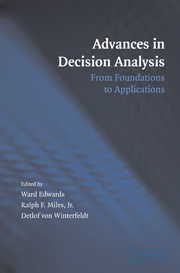Book contents
- Frontmatter
- Contents
- List of Contributors
- Preface
- 1 Introduction
- PART I HISTORY AND FOUNDATIONS OF DECISION ANALYSIS
- PART II STRUCTURING DECISION PROBLEMS
- PART III PROBABILITIES AND BAYES NETS
- PART IV UTILITIES
- PART V RISK ANALYSIS
- PART VI DECISION ANALYSIS IN A BEHAVIORAL AND ORGANIZATIONAL CONTEXT
- 18 What Have We Learned from Our Mistakes?
- 19 Decision Conferencing
- 20 Resource Allocation Decisions
- 21 From Decision Analysis to the Decision Organization
- 22 Building Decision Competency in Organizations
- 23 Negotiation Analysis: Between Decisions and Games
- PART VII APPLICATIONS OF DECISION ANALYSIS
- Index
- References
21 - From Decision Analysis to the Decision Organization
Published online by Cambridge University Press: 05 June 2012
- Frontmatter
- Contents
- List of Contributors
- Preface
- 1 Introduction
- PART I HISTORY AND FOUNDATIONS OF DECISION ANALYSIS
- PART II STRUCTURING DECISION PROBLEMS
- PART III PROBABILITIES AND BAYES NETS
- PART IV UTILITIES
- PART V RISK ANALYSIS
- PART VI DECISION ANALYSIS IN A BEHAVIORAL AND ORGANIZATIONAL CONTEXT
- 18 What Have We Learned from Our Mistakes?
- 19 Decision Conferencing
- 20 Resource Allocation Decisions
- 21 From Decision Analysis to the Decision Organization
- 22 Building Decision Competency in Organizations
- 23 Negotiation Analysis: Between Decisions and Games
- PART VII APPLICATIONS OF DECISION ANALYSIS
- Index
- References
Summary
ABSTRACT. Decision analysis has been successfully cast as an intervention to pull together the right team of people to formulate and solve the decision maker's problem by building economic models of the situation, assessing the crucial uncertainties, and determining the risk and return of each alternative. For large one-of-kind problems this method works well. Many organizations claim that they have made millions using it. Yet, in spite of its accomplishments, this model has had limited sustained success. Decision analysts often find themselves relegated to disempowered staff, delighted when the executive occasionally calls on them. With a few important exceptions, internal Decision Analysis groups have generally failed to withstand the test of time. We document and explore the ongoing shift from interventional decision analysis to the decision organization, an embedded ecology of actors and patterns of behavior that needs to be guided to produce a sustainable pattern of good decisions. Enabled by the stunning increase in computing power and connectivity, organizational decision analysts need to use the old tools in new and more productive ways and to guide the organizational decision ecology toward sustainable profitability and growth. What will it mean to be a professional decision analyst in the twenty-first century?
Decision Analysis was originally framed as an intervention to assist major organizations in making large, one-of-a-kind decisions (Howard 1966; Raiffa 1968; Howard and Matheson 1983). In its earliest form, it focused on decision makers who already realized they were facing difficult choices and wanted a more rational way to reach them.
- Type
- Chapter
- Information
- Advances in Decision AnalysisFrom Foundations to Applications, pp. 419 - 450Publisher: Cambridge University PressPrint publication year: 2007
References
- 3
- Cited by



